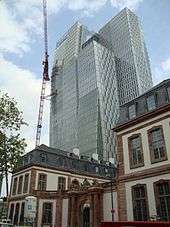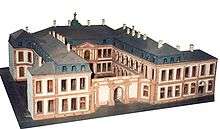Palais Thurn und Taxis
The Palais Thurn und Taxis (German: [paˈleː ˈtuːɐ̯n ʊnt ˈtaksɪs]) in Frankfurt, Germany was built from 1731 to 1739 by Robert de Cotte and commissioned by the Imperial Postmaster, Prince Anselm Franz von Thurn und Taxis (1714–1739).

The building was heavily damaged in World War Two and then demolished. Today a reconstruction houses some shops.
History
In 1748 the castle was the administrative seat of the imperial post office, then operated by the Thurn und Taxis family, and from 1805 to 1813 it was the residence of the Prince Primate and Grand Duke of Frankfurt, Karl Theodor von Dalberg. After the restoration of the Free City of Frankfurt, it held the Bundestag of the German Confederation from 1816 to 1866.
In 1895 Prince Albert I von Thurn und Taxis sold the Palais to the Imperial Post. In 1905 the city of Frankfurt took over the palace and used it to house the Museum of Ethnology for the collections of the African explorer Leo Frobenius.
Demolition & reconstruction

During 1943 and 1944 the palace was badly damaged in the bombing of Frankfurt am Main in World War II, but much of the structure was preserved, such as some ceiling paintings and stucco. Although reconstruction was possible, it would have been too costly, and so much of the building was demolished in 1951. The remaining parts of the building were actually new buildings made from sections of the original, but with modern reinforced concrete and without the mansard roofs.
From 2004 to 2010 the palais has been reconstructed as part of the Palais Quartier development.